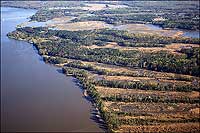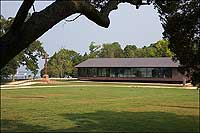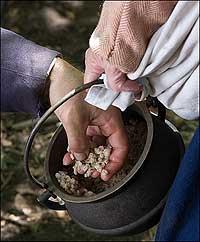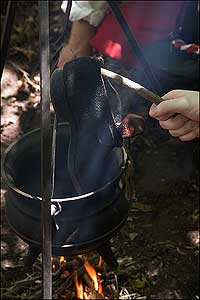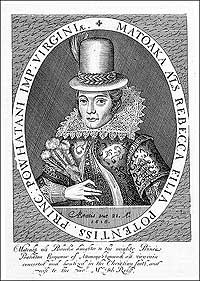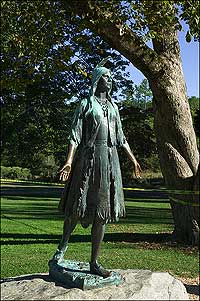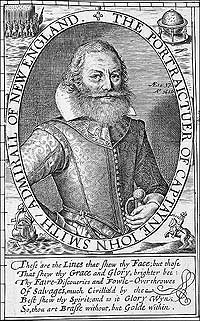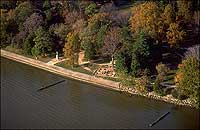"We are starved"
by Ivor Noël Hume
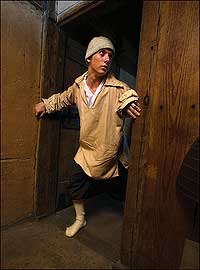
The Starving Time Jamestowners, one of them portrayed here by Jared Larson, ran out of their beds "Cryeinge owtt we are starved."
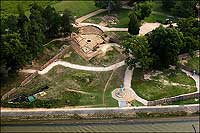
Jamestown fort at the edge of the James River, where, as George Percy wrote "There were never Englishmen left in a forreigne Countrey in such miserie." After the Starving Time of 1609–10, perhaps sixty of 500 English had survived famine, disease, and Indians.
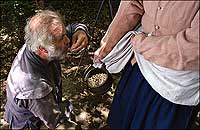
Swiftly running through the provisions shipped from England, the colonists did not plant enough to feed themselves and were reduced to "one smale ladle" of gruel a day. Interpreter Lindsay Gray accepts his pittance from Carol Farmer.
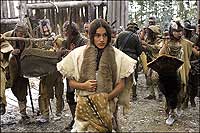
In The New World, Native Americans—Q'orianka Kilcher here as Pocahontas—traded food to starving Englishmen in 1608–9.
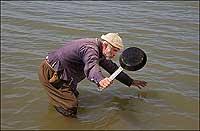
A frying pan proved a sorry tool for catching fish. Lindsay Gray flails at fish "lying so thicke" but comes up empty-handed.
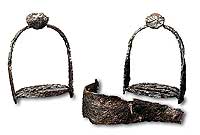
Stirrups and bridle recovered from Jamestown, useless after the English ate their horses and were reduced to rats, snakes, and mice and to grubbing for roots. When those resources were exhausted, colonists turned to eating the dead.
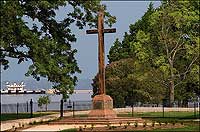
The wooden cross honors the Starving Time dead, scores of whom may be buried on the fenced ridge behind it.
Next only to the arrival of the English in 1607 and their departure in 1781, the months of the winter of 1609–10, known as the Starving Time, rank atop the memorable events of Virginia's history. Hundreds of settlers died for want of food. Some were reduced to cannibalism.
Since the first English fleet dropped anchor in the river they named for King James, off the island where they raised Jamestown, there had been a stream of arriving colonists to hew a living out of the relatively benign Virginia environment. Crops grew easily and readily ripened, fish were plentiful, game abounded in the forests, and if one was careful, wild plants, fruits, and nuts were edible. To transported Londoners this would have been as close to Eden as they could have imagined. So what went wrong?
Who were the hungry and why did they starve? The questions never have been adequately answered. More often than not historians have been content to say that it happened—but should not have.
The 1607 arrivals numbered 104 or 105 men and boys, of whom half were dead by year's end. Captain Christopher Newport, who had commanded the original fleet, returned with two ships of supplies early in 1608, but soon after he docked the fortified Jamestown caught fire. The conflagration destroyed most of the equipment and possessions already there. Rather than forwarding the settlement's progress, Newport's help focused on picking up the pieces from the charred ruins of the first year's meager accomplishments.
Nevertheless, his orders from the Virginia Company of London, the joint-stock enterprise that owned the colony, were to return with saleable commodities that would begin to repay the investors. Thus, the settlers spent a disproportionate amount of their time and energy sawing trees and splitting boards, not for their own home improvements but for building construction in England.
Although then-president George Percy identified the winter of 1609–10 as "this starveinge Tyme," it differed little from the periods of starvation that had beset the colony from the beginning. The settlers reported to the Virginia Company that as early as 1607,
They fell into extreame want, not having anything left to sustain them save a little ill conditioned Barley, which ground to meal & pottage made thereof, one smale ladle full was allowed each person for a meale, without bread or aught else whatsover.
The report, submitted by the "Ancient Planters nowe remaining alive in Virginia," said that had it not been for help from the Indians, the colonists "had all utterlie by famine perished." By "ancient," they meant "among the earliest," and by "planters," they meant "colonists."
As with twenty-first-century shortages, there was a surfeit of finger pointing. The colonists were quick to blame the government, specifically the "misgovernment of Sir Thomas Smith." Smith was the Virginia Company's chief executive back in England, who "aimed at nothing more than a perticular gaine to be raised out of the labours of such as both voluntarilie adventured themselves and were otherwise sent over at the common charge."
The survivors were saying that the company's primary interest was in getting the labor to Virginia and expecting it to fend for itself once it arrived while making money for the stockholders. In the light of the glowing reports of earlier English voyages to the New World, that was a reasonable assumption—at least to company executives seated in the comfort of their London offices. It might have been reasonable, too, if the apprentice settlers had known what they had to do and had the leadership to get it done. They didn't.
The locally governing seven-man Jamestown council—named before leaving England but not identified until it reached Virginia—spent more time jockeying for position than organizing the workforce. Its president, Edward Maria Wingfield, was ineffective and malleable in the hands of more aggressive members of his fractious council. Consequently, when the first of two supply ships arrived at Jamestown in January 1608, the famished survivors of the original 104 or 105 were living in cabins—soldiers' tents—and holes in the ground. Ten were fit to work, the remainder being "at point of death, all utterly destitute of houses." The blame for this "misgovernment" rested as much on the shoulders of the ancient planters as it did on Sir Thomas Smith and the company.
The supply ships, the John and Francis and the Phoenix, brought 120 more settlers, reportedly worse provided for than their predecessors, adding to the burden of feeding the colony. Another supply ship, the Mary Margaret, arrived at the end of September, adding sixty more unseasoned helpers—"mostly gentlemen" and few or no tradesmen—all of whose supplies were exhausted within two months. By that time, however, the feuding councilors had been sidelined by their least-liked member, Captain John Smith.
Smith, for a time, provided the unified leadership the colony had lacked. But not even he could coax crops to grow overnight, and at the year's end the ancient planters said that although they had cleared four acres for agriculture, there were "hunger & sickness not permitting any great matters to be donne."
Salvation—if there was to be any—lay in the hands of the Indians, whom the colonists called savages. Trading copper and beads for corn and even swords for turkeys kept England's precarious foothold alive through the winter of 1608–9. Had the Indians not been beguiled by the Europeans' tools and trinkets, the colony would have collapsed and the course of American history changed. Instead, the Indians traded their maize for a future of persecution and privation—a deal personified by the at-first nubile and later tragic figure of Pocahontas.
Although Smith said he did everything he could to whip the colony into shape, survivors of the old guard were plotting against him—and rats were in the storehouse. Not until it was too late did Smith discover that "in searching our casked corne, wee found it helfe rottern, the rest so consumed with the many thousand rats (increased first from the ships) that we knewe not how to keepe that little wee had...This did drive us all to our wits end."
Smith's solution was to divide the colonists into three groups, one to go downriver to modern Hampton at the mouth of the James to live on oysters, another to go upriver to establish a fort by the falls at modern Richmond, and the rest to remain at Jamestown. The Hampton group did more arguing than fishing, while contentions at the falls fort resulted in many being killed by the Indians or deserting to join them.
If we are to believe Smith, had his best endeavors not been frustrated by "envious authority," the Starving Time to come would have been averted. Even so, Smith's planning seems to have its shortcomings—like going fishing without a net.
In June 1608, Smith had headed an expedition to explore the estuaries of the Chesapeake Bay. Sailing in an open barge were the colony's doctor, seven gentlemen, and as many soldiers, one of whom was identified as Jonas Profit, a fishmonger. The fish, Smith said, were "lying so thicke with their heads above the water, as for want of nets we attempted to catch them with a frying pan: but we found it a bad instrument to catch fish with."
Netless fishing was but one of the many almost farcical failures that beset the colony before and after John Smith's presidency—which unexpectedly ended with a bang. On his way back from the fort at the falls a bag of gunpowder ignited and burned him so severely that his life was in doubt. When he did not die, and after an aborted assassination attempt, the Jamestown councilors shipped him home to England—in the interests of his recovery and future well-being.
The ailing George Percy, one of the remaining original councilors, succeeded Smith as president. He had inherited an almost empty storehouse. But thanks to Smith's efforts, crops had been growing and with the numbers of mouths to feed decreased as disease and the Indians took their toll, the situation was not as dire as it might have been. Besides, Percy knew that help was on its way.
On Friday, June 2, 1609, a fleet "of seven good ships and two pinnaces, weighed anchor from Plymouth Sound," bound for Jamestown. The flagship Sea Venture led the way with Admiral Sir George Somers in command and with a new charter and a governor, Sir Thomas Gates, to replace the Percy administration as well as Captain Newport and other senior officers aboard. Astern sailed the heavier transports loaded with supplies and five hundred soldiers and settlers, among them an unrecorded number of women and children. All went well until July 23, when "the clouds began to thicken around ...and a dreadful storm commenced from the north east." A hurricane raged for three days, wrecking the Sea Venture on a Bermuda reef and scattering and battering the rest of the fleet. After reassembling and assessing the damage, the fleet limped into the James on August 11 having suffered "a great loss of men by calenture," a tropical fever, "and most of them all much weatherbeaten."
To the embattled Percy, the rescue fleet was no help. Gates, the new governor, had apparently been lost at sea, but three argumentative colleagues, John Ratcliffe, Gabriel Archer, and John Martin, who had gone home the year before, were now back with their own axes to grind. Unable to house the near five hundred new arrivals, Percy billeted them in the colony's seven-acre field of planted corn, which they "in three days at the most, wholly devoured."
Faced with spreading disease and the likelihood of insurgency, Percy decided once again to split the colony into three parts. He reduced Jamestown to a small garrison, ordered inexperienced twenty-two-year-old Captain Francis West upriver to the falls, and Ratcliffe to build forts at the mouth of the James to augment another on the south side held by the difficult Martin.
Martin soon quit and returned to Jamestown, leaving his men to fend for themselves. Mutiny followed and so did the Indians. The mutineers fled and were killed, as were the remaining soldiers. Percy next sent Ratcliffe with a fifty-man force to the Indian headman, emperor Powhatan, to trade for maize. The negotiations did not go well. Sixteen men made it back—empty-handed, Ratcliffe having been flayed and burnt alive by Indian women "and so for want of circumspection miserably perished."
Percy sent West with thirty-six men in a small ship, the Swallow, to trade with the Indians of the Potomac, which they did. Returning to Ratcliffe's fort at the mouth of the James, West was assured that Jamestown was in dire need of the maize, apparently heard that there was cannibalism, and was urged to proceed upriver with all possible speed. The Swallow's crew had a better idea. It headed to sea and ate the maize on the voyage home to England.
The hard winter of the Starving Time reduced a population of about five hundred to barely sixty, "the reste beinge either sterved throwe famin or cut of by the Salvages," Gabriel Archer among them. Everything from the horses brought by the Gates fleet to rats, snakes, mice, and roots dug from the forest were consumed, and emaciated survivors took to eating the dead.
On May 22, 1610, two small ships appeared in the James. Aboard were the crew and passengers of the wrecked Sea Venture, all well nourished from nine months of relatively easy living on the islands of the Bermudas. The survivors that the new governor, Gates, saw as he entered the fort at Jamestown were, wrote Percy, "lamentable to behowlde them for many throwe extreme hunger have Runne outt of their naked bedds being so Leane that they Looked Lyke Anotamies Cryeinge owtt we are starved." The settlement, Gates wrote, looked more like "the ruins of some auntient" fortification "then that any people living might now inhabit it."
Having no immediate remedy and no knowledge of any relief coming from London, Gates resolved to abandon Jamestown and take the survivors home. On June 7, they boarded his small ships and left their dilapidated fort and ruined houses to be picked over by the Indians. Powhatan had won. England's Virginia colony was no more.
But for Jamestown, as Winston Churchill wrote in the context of a later disaster, that was only the end of the beginning.
Williamsburg's Ivor Noël Hume contributed to the Holiday 2006 journal "Pocahontas's London Christmas: Beans, Peas, and Sea-coal; or, Who Killed Pocahontas?"
Suggestions for further reading:
- Philip L. Barbour, ed., The Complete Works of Captain John Smith (Williamsburg, VA, 1986).
- "A Breife Declaration of the Plantation of Virginia duringe the first Twelve Yeares ...," in Colonial Records of Virginia (Baltimore, 1973).
- Charles E. Hatch Jr., The First Seventeen Years: Virginia, 1607–1624 (Charlottesville, VA, 1957).
- The Jamestown Voyages under the First Charter, 1606–1609 (Cambridge, 1969).
- George Percy, "A Trewe Relacyon ...&c." Tyler's Quarterly Magazine 3 (1922): 259–82.
- William Strachey, "William Strachey's Unrecorded First Draft of His Sea Venture Saga," in Ivor Noël Hume, ed., Avalon Chronicles, vol. 6 (Newfoundland, 2001).

